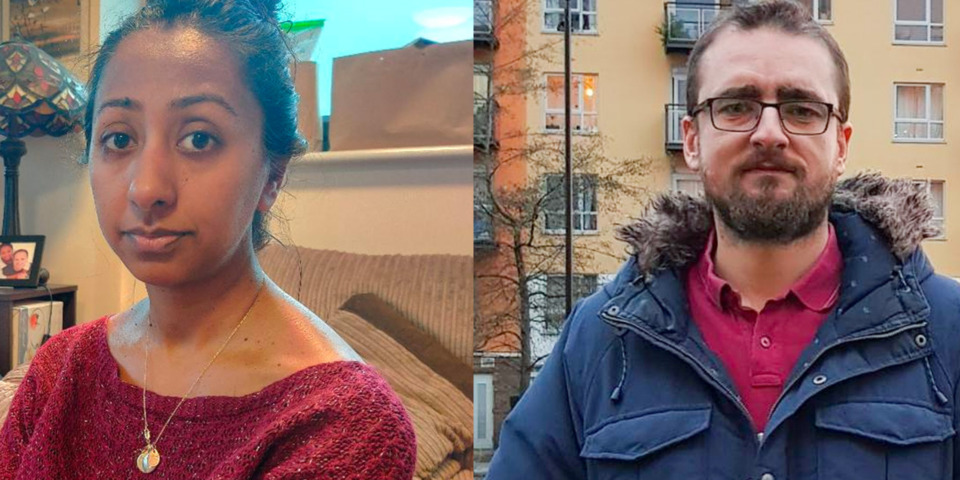Shared ownership homeowners fear dealing with the entire cost of cladding remediation bills


Leaseholders who bought their houses through the shared ownership scheme could still face the entire costs of cladding remediation bills, despite only owning minority shares within their flats.
With remediation bills sometimes running into the thousands, some shared ownership leaseholders could end up facing bills higher than the equity they've within their homes.
Which? spoke to three individuals who reside in homes bought through shared ownership, and who now fear bills for building safety issues could bankrupt them.
What is shared ownership?
Shared ownership (also known as ‘part buy, part rent’) is definitely an affordable housing scheme that allows low-income buyers to purchase part of a home and pay a subsidised rent on the rest.
The minimum stake you can buy through shared ownership is 25%, though this is lowered to 10% this year.
Buying a share in a property requires saving a smaller deposit and getting a smaller mortgage, that is designed to make it an affordable route into homeownership.
For example, on the property worth lb150,000 you can buy a 25% share (worth lb37,500) while the remaining share (worth lb112,500) is owned by a housing association. You can normally purchase your share of the property having a 5% deposit (lb1,875) and remove a home loan for the rest (lb35,625) but you will also have to pay rent towards the housing association (normally around 2.75%) around the share that you don’t own.
The idea is the fact that shared owners can incrementally purchase a larger proportion of the home until they own all of it. This is whats called ‘staircasing’.
The English Housing Survey estimates there are approximately 157,000 households living in shared ownership homes in England.
- Find out more: shared ownership explained
Why shared owners might have to pay to fix unsafe cladding
Even though they merely own a part of their homes, shared owners have the effect of paying the full costs of maintenance.
'I envisioned having to deal with things like the boiler,' said Timea Szabo a 37-year-old leaseholder from London. 'I knew I'd need to pay to replace it all, and 100% of that.'
But she didn't expect to have to pay for to get rid of unsafe cladding from the building's outer walls. 'Never at any time does anyone say you will be made responsible for maintaining the outside of the building,' she said. 'I don't think cladding replacement is maintenance. This is an upgrade.'
Though Timea was told she'd be responsible for the entire price of her flat's maintenance, nobody warned her concerning the possibility of external building maintenance when she was buying through the government scheme.
'I feel I had been trapped into this complete thing. Because that's a really, really big thing that I may wish to be warned about. This is a really huge, potentially detrimental clause. With no one said anything.'
Because a building's owners can legally pass on costs to residents who bought through shared ownership, shared owners across the country might be facing large bills, despite standing on lower incomes. Not only bills for cladding, however for expensive waking watches and rocketing insurance premiums too.
The government announced a new round of funding for removing cladding from certain eligible buildings last week, which might help some shared owners however this won't cover the costs of waking watches and insurance, or of repairs to other widespread building issues of safety, for example missing cavity barriers.
Hear more: the Which? Money Podcast explores the cladding scandal
'It seems like an entire and utter trap now'
Timea Szabo purchased a 30% share of her flat in December 2021. 'That's all I possibly could afford,' she told us. 'I was uneasy, but it was doable.'
The flat is part of the large Royal Artillery Quays rise in Woolwich, southeast London. Timea wanted to create a stable home in the region on her son. 'It wasn't more costly than renting around here and so i thought overall will still be a better option because of the stability and also the security.'
Timea had purchased a flat through shared ownership before, and knowning that flat, she'd a good experience. But this time it was different.
'I never used to become cynical. I had been quite positive about shared ownership, but this situation has thrown up each one of these problems that Irrrve never even knew about.'
Royal Artillery Quays residents happen to be told their cladding bill might be lb13m. If passed on to leaseholders, this might are more expensive than lb35,000 each. Timea says she wouldn’t have the ability to pay it.
'If I'd an extra lb40,000 or lb50,000 lying around I'd be living in a house, not really a flat,' she said.
At the moment, she doesn't determine if the balance will be passed onto her, but she's already seen something charge increase over the years.
'The whole point to be a shared owner is that you're on a low income,' she said. 'So using a lb200 rise in your service charges can push you over the edge. With my case it kind of has.
'I'm a solo parent, I haven't got another income source in this house, it's me. I can not pay it.
'I feel trapped. Everything I've ever had is in this flat.'
Timea's biggest worry is perfect for her son. 'That's what upsets me probably the most, that I was trying to do this for him and he will miss out probably the most because I will lose the financial stability I had.'
‘In the event that bill does arrived at us, it’s going to be huge’
Deepa Mistry-Longley bought 75% of her London flat through shared ownership in 2010.
She doesn't know if she'll have to pay for cladding remediation, however the building safety crisis has left her held in an increasingly expensive home that her family members have outgrown.
'When When i first bought, it had been at the very top end of my affordability, and so i couldn't really have any better than that,' she told us. 'I think four or five years onwards the bills have started to increase, and they've slowly edged up to and including point where they're becoming quite unaffordable.'
Ten years after she got it by herself, Deepa's family members have outgrown the two-bedroom flat. 'My husband and that i share our bedroom and then the kids share their own bedroom,' she said. 'We're quite crammed doing any work, homework which kind of thing.'
Naturally, her plan was to sell the flat and move somewhere bigger, but potential building issues of safety stop this.
The cladding on Deepa's building was remediated 3 years ago. The job was done after the Grenfell Tower fire, so she assumed it would be safe. Regardless of this, she's been unable to secure an EWS1 certificate – the elusive form that mortgage lenders require to prove a building isn't dangerous. 'That's all we would like. We simply need the certificate.'
She has been chasing her housing association about you get one for more than annually, but she still does not have one. Many buildings have struggled to secure EWS1's, as improving demand for services outweighed the small number of qualified surveyors available to carry out the assessment.
Unable to move, Deepa is trapped in her flat with a high-interest mortgage as well as an increasing monthly service charge.
So far, she hasn't been given any bills for cladding work, but she hasn't received confirmation that she will not be expected to pay for the work carried out 3 years ago. 'If that bill does arrived at us, it's going to be huge,' she said.
Deepa has heard flats in other buildings are facing bills of lb10,000 or even more for cladding remediation, and worries what can happen if hers was exactly the same. 'How are they expecting me to generate that sort of cash?' she said.
'The government seems to believe that this ought to be left to us. They ought to be living in a different world. It's a completely different world to the leaseholders who live in these kinds of properties.'
Deepa is not able to remortgage to reduce her monthly obligations because her income has decreased since she stopped full-time employment. And since she can't sell, this makes her what is known as a 'mortgage prisoner'.
‘I’ve lost faith in the entire leasehold system’
Savvas Chatziparaskevaidis lives with his daughter and the wife in a flat she bought 35% of through shared ownership in 2021.
'It was the only method she could buy,' he explained of his partner’s decision to make use of shared ownership. 'It would be a first step around the ladder, there is no other way for her to afford a house in London.'
'I think until we found out about all of the issues, shared ownership felt just like a very good way to get around the property ladder.'
Like Deepa, Savvas and the family planned to move to accommodate their growing family. 'I've had a little one playing around. She's been running around for years but she needs extra space as she grows.'
They wanted to relocate summer 2021, which was when they found out they'd need an EWS1.
Savvas thought it would be a 'tickbox exercise'. 'We'll obtain the form and when we have it we'll move ahead,' he thought. This didn't work out this way.
When the EWS1 assessment arrived, the surveyor had found issues with the cavity behind the building's external facade. So as the building doesn't have dangerous cladding, it will still need to be remediated before residents can sell their flats.
Savvas knows his family will be accountable for all of any costs passed onto leaseholders, despite owning not even half from the flat. 'I do not understand how it's acceptable that, when you own 35% of the property, you're accountable for 100% of the remedial works on the design of the building.’
'This isn't something that's happened because of maintenance. With maintenance, you could reason that it's justifiable for us to cover it. This really is part of the design of the building.'
Arranging and undertaking the remediation work could take quite a long time, so Savvas reckons his family won't be able to re-locate for another 3 years. 'It's a hell of a wait,' he states.
'My emotions undergo waves. I was very angry at first. There's kind of this feeling of despair. But mostly I'm angry.'
Fixing the problems with shared ownership
In September 2021, the federal government published a response to some consultation on the problems with shared ownership.
It put down key features that would be introduced to help reform the shared ownership model, including a new 10-year free repair period. During this time maintenance and repair costs will be met through the housing provider.
The consultation recognised the issues shared owners face. It stated: ‘Shared owners, like other homeowners, are currently responsible for all of the maintenance of their home and contribute for the full cost of any repairs from day one. Which means that those beginning having a small stake can be playing large bills.
‘For most of us entering into shared ownership, the scheme works as a first step on their own journey as homeowners. The new repairs model will better bridge the gap between renting and homeownership. The changes may prevent new shared owners being hit with repairs and maintenance bills and better support these to put money aside towards buying much more of their home.’
However, the consultation document states the new shared ownership model will only apply to shared ownership homes delivered with the government’s Affordable Homes Programme (AHP) 2021-26 from 1 April 2021, so existing shared owners for example Timea, Deepa and the Chatziparaskevaidis family are unlikely to be able to benefit.






